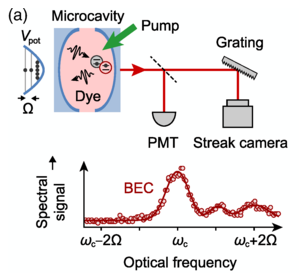Work by ML4Q Young Investigator Julian Schmitt and his team was recently published in Physical Review Letters. The discussed results show that fluctuations and response of a BEC to a bath of molecules are directly linked by thermal energy. The results demonstrate “the validity of the fluctuation-dissipation theorem for a Bose-Einstein condensate”, the authors argue.

Experimental scheme to measure the number fluctuations and the response function of a photon Bose-Einstein condensate coupled to a reservoir inside a dye microcavity. Part of the cavity emission recorded with a photomultiplier (PMT) yields the mean condensate population ⟨n⟩; the other part is dispersed on a grating, and the spectrally filtered condensate evolution is recorded with a streak camera, giving g(2)(τ) and the dye-cavity detuning Δ. Bottom: time-integrated spectrum showing the condensate mode at ωc, well separated from the first excited states in the harmonic potential with trapping frequency Ω. [Source: Figure 1 of the publication]
Publication: Fahri Emre Öztürk, Frank Vewinger, Martin Weitz, and Julian Schmitt, Fluctuation-Dissipation Relation for a Bose-Einstein Condensate of Photons, Phys. Rev. Lett. 130, 033602 (2023)
https://journals.aps.org/prl/abstract/10.1103/PhysRevLett.130.033602